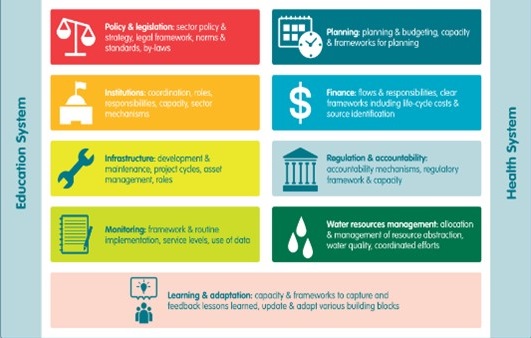Strengthening Systems for Long-Term Impact
SWSC’s Phase IV strategy focuses on improving systems for education, health, and WASH (water, sanitation, and hygiene) by using a systemic approach. This method helps service providers enhance quality and sustainability, ensuring long-term benefits for communities. Instead of relying on a single solution, system strengthening combines multiple strategies to create lasting change.
Four Key Principles of System Strengthening
- Solving Root Problems, Not Just Symptoms This approach looks at how different parts of a system interact, identifying deeper issues rather than quick fixes. Small, strategic changes can create major improvements over time.
- Ensuring Long-Term Sustainability Infrastructure alone doesn’t guarantee lasting success. Strengthening policies, budgeting, and coordination helps organizations maintain WASH services beyond individual projects.
- Expanding Impact Beyond Project Timelines The goal is for local actors to continue their work independently, ensuring services remain effective long after external support ends. Since system change takes time, monitoring progress is essential.
- Temporary Role of External Organizations: Technical and financial partners should facilitate change rather than replace local systems Providing temporary support and guidance to local actors, with the aim thatimprovements remain sustainable.
How System Strengthening Works
Organizations typically begin by assessing the system’s current state using the building blocks (see figure 1), understanding key players, defining a shared vision, and implementing change while tracking progress. The Market Systems Development (MSD) model, also called the Inclusive Systems Approach (ISA), provides structured steps to strengthen existing systems instead of creating temporary solutions.
Temporary actors, such as development organizations and donors, contribute expertise, help analyze problems, and coordinate discussions between different stakeholders. Since their involvement is short-term, they must plan early on how the system will function after they exit. Local NGOs play a critical role in bridging external support and long-term sustainability by offering advocacy, training, and program execution.
Ultimately, system strengthening requires a shift in thinking—moving from short-term fixes to building self-sufficient, adaptable structures that continue delivering essential services beyond any single intervention.
Applying System Strengthening in Fragile Contexts
Strengthening systems in fragile environments—where insecurity, weak governance, and economic instability are challenges—requires a tailored approach. The absence of stability often affects how well institutions can function, making careful analysis essential to avoid unintended harm and ensure conflict-sensitive programming.
Engaging with all system actors, especially governments, may not always be possible. However, other stakeholders—such as service providers, businesses, civil society, faith-based groups, and local Red Cross societies—can still be involved.
In fragile contexts, humanitarian organizations often step in to provide essential services. While this intervention is necessary in emergencies, it’s important to transition back to long-term solutions as soon as possible. Strengthening local systems reduces dependence on humanitarian aid and helps restore trust between governments and communities.
Planning for a smooth transition from crisis response to long-term development starts by identifying key actors and functions that need to be reinstated. Training local organizations in disaster preparedness and risk management also enhances resilience, making communities better equipped to handle future challenges. Collaboration between local authorities, humanitarian organizations, and WASH system operators ensures that essential services continue functioning even in difficult conditions.
By focusing on strengthening local systems and empowering key actors, communities can build resilience, maintain essential services, and reduce reliance on external aid over time.
Understanding WASH System Building Blocks
Because WASH systems are complex, it can be difficult to grasp how different actors and functions interact. Building blocks have emerged as a tool to break down this complexity, helping organizations understand how various components work together to maintain and improve WASH services. Each building block represents key functions, including the people and processes that make them work, with some actors contributing to multiple blocks.

IRC WASH’s building block framework is widely recognized, with slight adaptations used by different organizations. While this approach helps create a clearer mental model, it’s important to avoid oversimplifying the dynamic relationships that drive the system. Adjusting building blocks to fit specific contexts ensures they remain practical and useful for local WASH stakeholders.
Since WASH systems connect with health and education sectors, understanding these overlaps is crucial for strengthening services. Policy decisions, funding, and collaboration across these sectors influence how WASH improvements take shape. Tools such as WASH FIT, which align with broader health sector priorities for WASH in health care facilities, address key functions and processes within various building blocks.
Beyond using building blocks as a framework, some organizations assess their strength through participatory evaluations. This approach helps ensure that interventions are tailored to the specific needs of each context, making system strengthening efforts more effective.